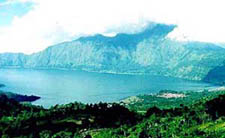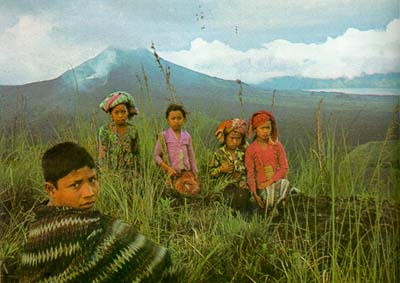
Penelokan
|
|
From the
bamboo forests
north of Bangli, the road emerges to a lookout above a huge volcanic
basin. Ribbons of black lava ripple down the valley from the misty peak
of Mt. Batur.
|

|
|
This is
Penelokan, "the
place to look", where the world changes colors. Sometimes, the still
lake there resembles blue glass, and at others, a sheet of platinum. In
chartreuse and vermilion bonuses, the mountain grasses stride along the
rim of an ancient crater surrounding Mt. Batur.
|
|
Legend
tells of Pasupati
(Siwa) dividing the sacred Hindu mountain Mahameru and placing the
halves in Bali, as the volcanoes Gunung Agung and Batur. Next to Agung,
Batur is the most revered of Bali's mountains. Temples throughout the
island honor the deity who dwells at its summit. Penelokan is a good
place to make a lunch stop at one of its high standard restaurants. A
short steep corkscrew road leads down to Kedisan on the lakeside where
boats can be hired. On the flank of the volcano opposite Trunyan at
Tirta Bungka, are hot springs set beside the cold waters of the lake,
nature's sauna for tired travelers who have climbed Mt. Batur. Nearby,
the hotel Tirta Yatra, is a convenient place to stay before or after
climbing the volcano.
|

|
|
Formerly,
the people of
this area lived relatively unperturbed at the base of the holy volcano.
In 1917, Batur violently erupted destroying 65,000 homes, 2,500 temples
and more than a thousand lives. Lava engulfed the village of Batur but
miraculously stopped at the foot of the temple. The people took this as
a good omen and continued to live there. In 1926, a new eruption buried
the entire ternple except the highest shrine, dedicated to God in his
manifestation as Dewi Danu, goddess of the lakes and waters. The
villagers were then forced to resettle on the high cliffs overlooking
Batur. They brought the surviving shrine with them and rebuilt the
temple, now known as Pura Ulun Danu of Batur village.
|
Copyright
© 2001-2011, K&D Bali Designs. All rights reserved.
|